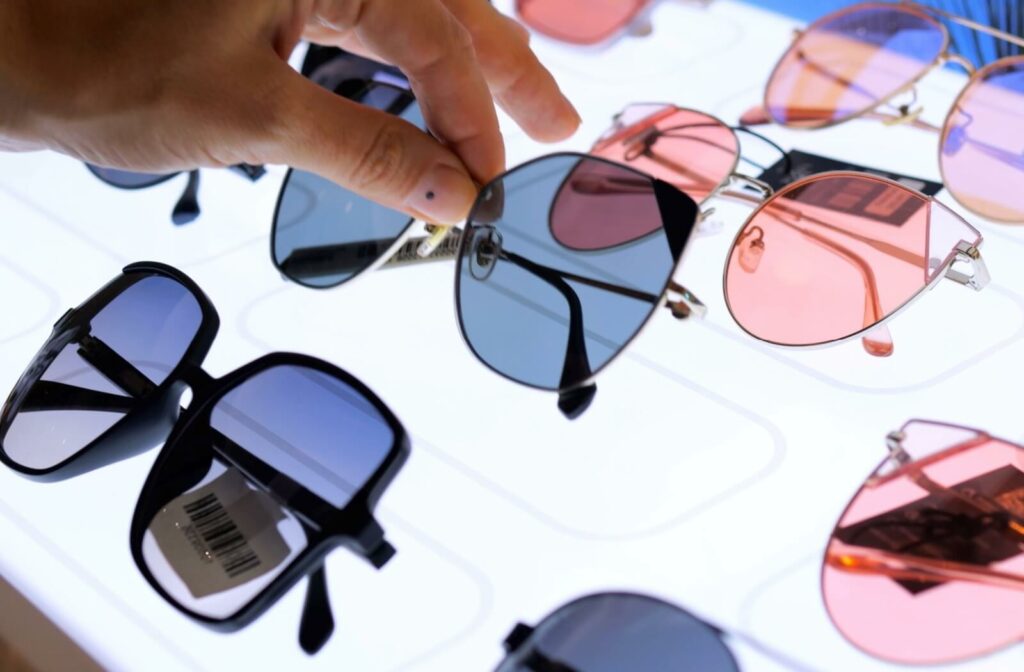Many people assume that all sunglasses offer the same protection and visual comfort. However, this isn’t the case. While polarized sunglasses eliminate glare, regular tinted glasses don’t—and this can have a huge effect on clarity.
Wondering whether your current sunglasses offer glare protection? Here’s a quick way to check: hold your sunglasses up to an LED screen on your phone or computer, then slowly rotate them 90 degrees. If the screen appears to darken or black out during rotation, congratulations—you’re already wearing polarized lenses.
If you aren’t, it might be time to consider an upgrade for your eye health.
Polarized vs. Non-Polarized: Understanding the Difference
There are some key differences between polarized and non-polarized lenses.
Non-Polarized Lenses
Non-polarized sunglasses reduce overall brightness by filtering out a portion of incoming light. While this makes sunny conditions more comfortable, these lenses do little to address glare.
Polarized Lenses
Polarized sunglasses offer additional benefits. These lenses feature a special coating that reduces glare by blocking horizontally reflected light waves. This targeted filtering is often particularly valuable in environments where light bounces off reflective surfaces such as water, roads, and snow, as it improves clarity, results in sharper vision, and reduces eye strain.
How Polarized Glasses Support Eye Health
When discussing eye protection, UV radiation is always a serious concern. The sun emits three types of ultraviolet rays:
- UV-A
- UV-B
- UV-C
While Earth’s atmosphere filters out most UV-C rays, UV-A and UV-B radiation reaches us daily, potentially causing significant eye damage over time.
Both polarized and non-polarized sunglasses can offer UV protection. However, polarized lenses provide an additional layer of protection by reducing the intensity of glare.
The Dangers of UV Rays to Your Eyes
Extended UV exposure poses serious risks to your long-term eye health. Unlike your skin, your eyes don’t develop a protective “tan,” making them particularly vulnerable to cumulative UV damage.
Prolonged exposure can lead to several concerning conditions:
- Photokeratitis can occur relatively quickly, causing pain, tearing, and temporary vision problems.
- Macular degeneration affects the retina’s central portion, potentially leading to significant vision loss over time.
- Cataracts develop when UV exposure causes proteins in your eye’s natural lens to break down and clump together, creating cloudy areas that interfere with clear vision.
- Growths on the eye, both cancerous and non-cancerous, can develop on various parts of the eye.
Regular eye exams and proper protection remain your best defence against these conditions. Polarized sunglasses contribute to this protection by reducing the intensity of bright, reflective light that forces your eyes to work harder and experience additional strain.
The Benefits of Polarized Sunglasses

The mechanism behind polarized lenses is elegantly simple yet remarkably effective. The special coating absorbs horizontal light waves—the primary culprits behind glare—while allowing vertical light waves to pass through. This selective filtering dramatically reduces glare and improves overall visibility.
Driving
Driving can be significantly more comfortable and safer with polarized lenses. Road glare, particularly problematic during wet conditions or when the sun sits low on the horizon, virtually disappears. You’ll notice improved visibility of road signs, better definition of lane markings, and reduced eye fatigue during long trips.
Water Sports
Boating and fishing enthusiasts particularly benefit from polarized lenses. Polarization minimizes the glare reflecting off water surfaces, actually allowing you to see beneath the surface. Anglers can spot fish more easily, while boaters gain better visibility of obstacles, shallow areas, and other watercrafts.
Outdoor Activities
General outdoor activities such as hiking, cycling, or jogging become more enjoyable with enhanced clarity and reduced eye strain. You’ll notice improved depth perception, better color definition, and less squinting, allowing you to focus on enjoying your activities rather than fighting visual discomfort.
When Polarized Sunglasses Might Not Be Ideal
Despite their many benefits, polarized sunglasses aren’t universally appropriate. Certain situations call for non-polarized alternatives to maintain safety and optimal visibility.
- Winter driving. Polarized lenses can make it difficult to spot icy patches on roads, potentially creating safety hazards.
- Winter sports. Activities such as skiing and snowboarding require ice and terrain visibility. Non-polarized lenses often provide better definition for spotting icy spots, moguls, and other surface variations.
- Screen visibility. LED screens on phones, GPS devices, or dashboard displays may appear dark or completely black when viewed through polarized lenses.
- Operating heavy equipment or working in low-light industrial environments. These activities often require unobstructed light, making non-polarized lenses more practical for maintaining optimal visibility and safety.
How to Tell If Your Sunglasses Are Polarized
Determining whether your current sunglasses are polarized is surprisingly straightforward. Here are two easy tests:
- The reflective surface test provides the most reliable results. Hold your sunglasses up to a reflective surface like a car window, glass tabletop, or polished countertop. Look at the reflection through one lens, then slowly rotate the glasses 90 degrees. If this reflection significantly changes intensity during the rotation, your lenses are polarized.
- The LED screen test offers another quick verification method. View an LED screen (smartphone, computer monitor, or tablet) through your sunglasses, then tilt the glasses 90 degrees. Polarized lenses will cause the screen to darken dramatically or appear completely black at certain angles.
Remember that not all polarized lenses offer the same quality or level of protection. For the best results and proper UV protection, purchase sunglasses from your eye care provider who can verify the quality of the lenses you purchase.
Prioritize Your Eye Safety this Summer
The difference between polarized and regular sunglasses extends far beyond marketing claims or price points. These lenses offer tangible improvements in visual comfort, clarity, and protection that can enhance both your daily activities and long-term eye health.
Ready to experience the clarity and comfort that quality polarized sunglasses provide? Schedule an eye exam with Vivid Eye Care to find your next perfect pair of sunnies!






















